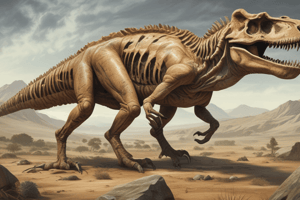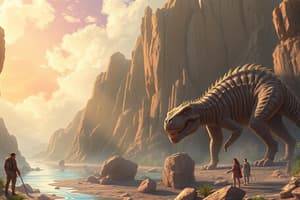Podcast
Questions and Answers
What defines a fossil?
What defines a fossil?
- The preserved remains or traces of a once-living organism. (correct)
- An ancient ecosystem without any traces of organisms.
- A structure created by geological processes.
- The remains of a current living organism.
Which of the following is an example of a fossil that provides insight into ancient marine ecosystems?
Which of the following is an example of a fossil that provides insight into ancient marine ecosystems?
- Fossilized plants like ferns.
- Human artifacts.
- Dinosaur bones.
- Fossilized ammonites. (correct)
What role do paleontologists play in the study of fossils?
What role do paleontologists play in the study of fossils?
- They study fossils to understand ancient organisms and environments. (correct)
- They analyze current living organisms.
- They create new fossils in laboratories.
- They focus on living plants and their interactions.
Which statement about evolution is accurate?
Which statement about evolution is accurate?
What evidence can be found in the fossil record regarding the evolution of horses?
What evidence can be found in the fossil record regarding the evolution of horses?
Which of the following fossils shows the transition of dinosaurs to birds?
Which of the following fossils shows the transition of dinosaurs to birds?
What notable discovery is associated with Mary Anning?
What notable discovery is associated with Mary Anning?
How does the fossil record contribute to our understanding of evolutionary history?
How does the fossil record contribute to our understanding of evolutionary history?
What is the primary mechanism driving evolution as described?
What is the primary mechanism driving evolution as described?
Which is an example of natural selection in action?
Which is an example of natural selection in action?
What occurs when a species completely dies out?
What occurs when a species completely dies out?
Which factor did NOT contribute to the extinction of the dodo bird?
Which factor did NOT contribute to the extinction of the dodo bird?
What best defines adaptation in organisms?
What best defines adaptation in organisms?
What is an example of a physical adaptation?
What is an example of a physical adaptation?
Which of the following is true regarding the causes of extinction?
Which of the following is true regarding the causes of extinction?
What role does sexual selection play in the survival of species?
What role does sexual selection play in the survival of species?
Which of the following statements correctly describes a species?
Which of the following statements correctly describes a species?
What defines an era in the geologic time scale?
What defines an era in the geologic time scale?
Which era is known as the Age of Mammals?
Which era is known as the Age of Mammals?
What is the primary characteristic of a period in the geologic time scale?
What is the primary characteristic of a period in the geologic time scale?
Which period is associated with the diversification of life during the Cambrian Explosion?
Which period is associated with the diversification of life during the Cambrian Explosion?
Which extinction event is noted as the most severe in Earth's history?
Which extinction event is noted as the most severe in Earth's history?
What distinguishes an epoch from a period in the geologic time scale?
What distinguishes an epoch from a period in the geologic time scale?
Which of the following best describes the significance of the Quaternary Period?
Which of the following best describes the significance of the Quaternary Period?
What significant event marks the beginning of the Holocene Epoch?
What significant event marks the beginning of the Holocene Epoch?
Which of the following epochs is characterized by the presence of early humans?
Which of the following epochs is characterized by the presence of early humans?
What does the Cambrian Explosion refer to?
What does the Cambrian Explosion refer to?
Which of the following animals is NOT associated with the Cambrian Period?
Which of the following animals is NOT associated with the Cambrian Period?
During which period did the Triceratops live?
During which period did the Triceratops live?
What defining trait characterized the Mesozoic Era?
What defining trait characterized the Mesozoic Era?
Which of the following describes the Stegosaurus?
Which of the following describes the Stegosaurus?
Which of the following best describes the Miocene Epoch?
Which of the following best describes the Miocene Epoch?
What distinctive feature do amphibians possess that aids in their life cycle?
What distinctive feature do amphibians possess that aids in their life cycle?
Which of the following correctly describes the term 'prehistoric'?
Which of the following correctly describes the term 'prehistoric'?
In what lifespan stage do axolotls retain their larval features?
In what lifespan stage do axolotls retain their larval features?
How does carbon dating determine the age of a sample?
How does carbon dating determine the age of a sample?
Which event is considered part of prehistoric times?
Which event is considered part of prehistoric times?
What characteristic is unique to salamanders compared to most other amphibians?
What characteristic is unique to salamanders compared to most other amphibians?
Which of the following best defines the Stone Age in relation to prehistoric times?
Which of the following best defines the Stone Age in relation to prehistoric times?
What is a significant limitation of carbon dating?
What is a significant limitation of carbon dating?
Flashcards are hidden until you start studying
Study Notes
Fossils
- Fossils are preserved remains or traces of once-living organisms, including bones, teeth, shells, and footprints.
- They provide crucial insights into the history of life on Earth and the evolutionary changes of organisms.
- Notable examples include dinosaur fossils (e.g., Tyrannosaurus rex), fossilized ammonites indicating ancient marine life, and fossilized plants such as ferns.
Paleontology
- Paleontology is the scientific discipline that studies fossils and ancient life forms to understand their history and evolution.
- Important figures include Mary Anning, known for her significant fossil discoveries in England.
- Fossils also include insects trapped in amber, offering detailed anatomical insights.
Evolution
- Evolution refers to the gradual change in living organisms over time, primarily driven by natural selection.
- Key evolutionary examples include the size increase and limb lengthening in horses, the transition of whales from land mammals to marine animals, and the evolution of birds from dinosaurs, as evidenced by feathered fossil finds.
Natural Selection
- Natural selection is a mechanism of evolution where advantageous traits become more common in a population across generations.
- An example is giraffes, where individuals with longer necks survive better by reaching higher leaves.
- This process is also observed in insects developing pesticide resistance and birds with brighter plumage attracting more mates.
Extinction
- Extinction is the complete disappearance of a species from Earth, caused by natural or anthropogenic factors.
- Historical examples include the extinction of dinosaurs around 65 million years ago, the dodo bird in the 17th century, and the passenger pigeon in the early 20th century.
Adaptation
- Adaptation is the process by which organisms modify traits for improved survival in their environment.
- Examples include the long neck of giraffes for reaching food, webbed feet of ducks for swimming efficiency, and the hibernation behavior of bears for survival during food shortages.
Species
- A species is a group of organisms that can interbreed to produce fertile offspring, sharing similar characteristics.
- Humans belong to the species Homo sapiens, while dogs are categorized under Canis lupus familiaris, including various breeds.
- Lions and tigers are distinct species, capable of producing hybrids like ligers, but these offspring are often infertile.
Era
- An era is a significant division of geological time characterized by major climate or biotic changes.
- The Mesozoic Era (252-66 million years ago) is known as the Age of Dinosaurs, while the Cenozoic Era marks the rise of mammals.
- The Paleozoic Era (541-252 million years ago) is notable for the emergence of complex life forms.
Period
- A period is a subdivision of an era in geological history, marked by specific geological events or predominant organisms.
- The Cambrian Period (541-485 million years ago) witnessed rapid diversification of life, known as the Cambrian Explosion.
- The Permian Period ended with a major extinction event, while the Quaternary Period features the presence of humans.
Epoch
- An epoch is a smaller time division within a period that highlights specific geological or biological events.
- The current Holocene Epoch began approximately 11,700 years ago, while the Miocene Epoch (23-5.3 million years ago) saw diversification among mammals.
- The Pleistocene Epoch (2.6 million to 11,700 years ago) was characterized by ice ages and the presence of early humans.
Cambrian Explosion
- The Cambrian Explosion (541-485 million years ago) marks a time of rapid diversification of life forms.
- Major animal groups, including arthropods and chordates, emerged during this period.
- Notable fossils from this time include trilobites and Anomalocaris, with the Burgess Shale providing well-preserved specimens.
Dinosaurs
- Dinosaurs were dominant reptiles for over 160 million years and came in various forms, including both herbivores and carnivores.
- Significant species include Tyrannosaurus rex, known for its size and predatory nature, Triceratops with its distinctive frill and horns, and Stegosaurus, recognized for its back plates.
Mesozoic Era
- The Mesozoic Era (252-66 million years ago) features three periods: Triassic, Jurassic, and Cretaceous, with dinosaurs prominently dominating.
- The era witnessed significant evolutionary developments leading up to the mass extinction event.
Amphibians
- Amphibians, including frogs, toads, and salamanders, are cold-blooded vertebrates that undergo metamorphosis.
- They possess moist skin and typically lay eggs in aquatic environments.
- Salamanders exhibit regenerative abilities, and axolotls are notable for retaining larval features throughout their lives.
Prehistoric
- Prehistoric refers to the time before written records, encompassing most of human and Earth history.
- The Stone Age (2.6 million years ago to about 5,000 years ago) represents early human tool use.
- The extinction of dinosaurs (65 million years ago) and archaeological evidence provide insights into prehistoric cultures.
Carbon Dating
- Carbon dating, or radiocarbon dating, determines the age of organic materials by measuring radioactive carbon-14.
- This method helps date ancient human remains and extinct animal fossils.
- It serves as a crucial tool for understanding timelines in prehistoric research.
Studying That Suits You
Use AI to generate personalized quizzes and flashcards to suit your learning preferences.




